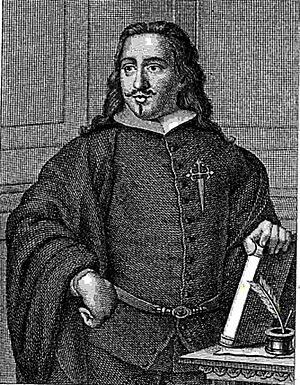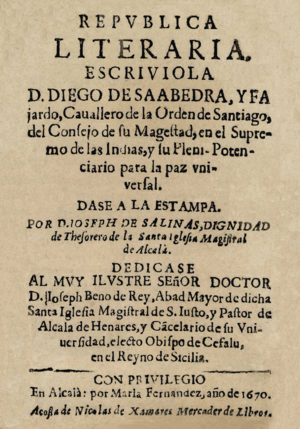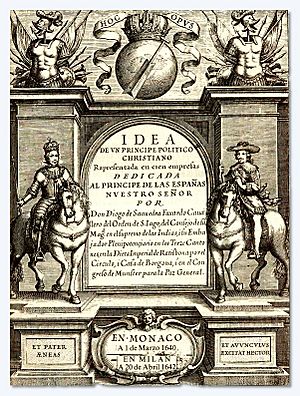Diego de Saavedra Fajardo facts for kids

Diego de Saavedra Fajardo (born May 6, 1584 – died August 24, 1648) was an important Spanish diplomat and writer. He spent many years working for the Spanish king, handling important political matters across Europe. He also wrote famous books, sharing his ideas on how a good leader should act.
About His Life
Diego de Saavedra Fajardo was born in Algezares, a town in what is now the province of Murcia, Spain.
He studied at Salamanca and later became a secretary to Cardinal Gaspar de Borja y Velasco. The Cardinal was the Spanish ambassador in Rome. This was in 1606.
Even though he did not become a priest, he was named a canon of Santiago in 1617. He also attended important meetings called conclaves. These meetings chose Popes Pope Gregory XV (in 1621) and Urban VIII (in 1623).
From this time on, he was very busy with diplomacy. King Philip IV of Spain trusted him greatly. Saavedra managed a large part of Spain's political and diplomatic work for 25 years. He worked in Italy, Germany, and Switzerland. This was a time when Spain's power in Europe was starting to decline.
He served as ambassador in Rome in 1631. In 1633, he went to Bavaria. This area was a central place for battles during the Thirty Years' War. He worked as the ambassador to Maximilian I, Elector of Bavaria. Maximilian was a leader of the Holy League. Saavedra tried to unite forces that supported the Habsburg family. He also worked to unite them with the German Emperor Ferdinand II and other Catholic powers.
In 1634, a big battle happened at Nördlingen. Swedish armies fought against the German empire and Spanish troops. The Spanish and German forces won this battle. In 1636, Emperor Ferdinand II died. Saavedra represented Spain at the meeting (called a Diet) in Regensburg. Here, a new emperor was chosen.
His diplomatic work became even more intense. This happened when Cardinal Richelieu declared war on Spain in 1635. Spanish troops faced many defeats by the French armies. Saavedra became a special representative (plenipotentiary) for Spain. He worked at Regensburg in 1636 and later at Münster in 1648.
After the Treaty of Münster was signed, Saavedra stopped his diplomatic work. He retired to a convent in Madrid. He died there in 1648. He is buried in the Cathedral Church of Saint Mary in Murcia.
His Writings
In 1640, Saavedra published a famous book called Empresas Políticas. Idea de un príncipe político cristiano. This title means "Political Maxims. Idea of a Christian Political Prince." It was a collection of one hundred short essays. These essays were about how a prince should be educated and govern. The book was written mainly for the son of King Philip IV. It became very popular and was printed many times. It was also translated into several languages.
He also wrote an unfinished history book. It was called Corona gótica, castellana, y austriaca políticamente ilustrada. This book appeared in 1646.
Another work by Saavedra was published after his death in 1670. It was called República literaria. This book is a funny discussion about important writers from ancient and modern times.
Saavedra's Idea de un príncipe político cristiano (1640) was a very learned book. It used a special literary style called an emblem book. This style was made popular by Andrea Alciato with his book Emblemata. Saavedra's book aimed to guide a Christian prince on how to be a good political leader. As a historian, he wrote Corona gótica, castellana y austríaca (1648). This book was meant to be a collection of biographies of the Visigothic kings of Spain.
What He Left Behind
A high school in the Infant Don Juan Manuel neighborhood of Murcia is named after Saavedra. In Algezares, his hometown, there is also a school with his name. The main street of Algezares is also named after him.
Madrid has a street named after him in the 28011 postal code area.
See also
 In Spanish: Diego de Saavedra Fajardo para niños
In Spanish: Diego de Saavedra Fajardo para niños



